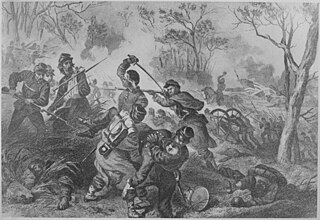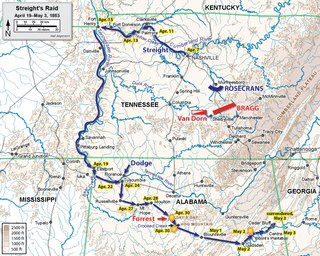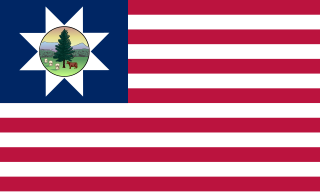
The siege of Port Hudson was the final engagement in the Union campaign to recapture the Mississippi River in the American Civil War. While Union General Ulysses Grant was besieging Vicksburg upriver, General Nathaniel Banks was ordered to capture the lower Mississippi Confederate stronghold of Port Hudson, Louisiana, to go to Grant's aid. When his assault failed, Banks settled into a 48-day siege, the longest in US military history up to that point. A second attack also failed, and it was only after the fall of Vicksburg that the Confederate commander, General Franklin Gardner, surrendered the port. The Union gained control of the river and navigation from the Gulf of Mexico through the Deep South and to the river's upper reaches.

The Vicksburg campaign was a series of maneuvers and battles in the Western Theater of the American Civil War directed against Vicksburg, Mississippi, a fortress city that dominated the last Confederate-controlled section of the Mississippi River. The Union Army of the Tennessee under Major General Ulysses S. Grant gained control of the river by capturing this stronghold and defeating Lieutenant General John C. Pemberton's forces stationed there.

Grierson's Raid was a Union cavalry raid during the Vicksburg Campaign of the American Civil War. It ran from April 17 to May 2, 1863, as a diversion from Maj. Gen. Ulysses S. Grant's main attack plan on Vicksburg, Mississippi.

The Horse Soldiers is a 1959 American adventure war film set during the American Civil War directed by John Ford and starring John Wayne, William Holden and Constance Towers. The screenplay by John Lee Mahin and Martin Rackin was loosely based on the Harold Sinclair (1907-1966) 1956 novel of historical fiction of the same name, a fictionalized version of the famous Grierson's Raid by Federal cavalry in April–May 1863 riding southward through Mississippi and around the Mississippi River fortress of Vicksburg during the Vicksburg campaign to split the southern Confederacy by Union Army Gen. Ulysses S. Grant.

Benjamin Henry Grierson was a music teacher, then a career officer in the United States Army. He was a cavalry general in the volunteer Union Army during the Civil War and later led troops in the American Old West.

The Battle of Yellow Tavern was fought on May 11, 1864, as part of the Overland Campaign of the American Civil War. Union cavalry under Maj. Gen. Philip Sheridan was detached from Grant's Army of the Potomac to conduct a raid on Richmond, Virginia, and challenged Confederate cavalry commander Maj. Gen. J.E.B. Stuart. The Confederates were outnumbered, and Stuart was mortally wounded. However, Sheridan's 'sideshow' did not achieve any of its other objectives and had meanwhile deprived Grant's army of key cavalry functions at Spotsylvania.
The Battle of Plains Store was fought on May 21, 1863, in East Baton Rouge Parish, Louisiana, during the campaign to capture Port Hudson in the American Civil War. Union troops advancing from Baton Rouge, Louisiana, clashed with 600 Confederates at a road junction. The initial Confederate force withdrew, but 400 more Confederates arrived from Port Hudson. Some of the Confederate reinforcement overran Union artillery and routed a Union regiment, but were unable to capture the guns. Union reinforcements advanced to the front, attacked part of the Confederate force and drove them from the field. The Confederates withdrew to Port Hudson, which was almost entirely surrounded by Union troops the next day. Port Hudson was under siege until the defenders surrendered on July 9.

The American Civil War saw extensive use of horse-mounted soldiers on both sides of the conflict. They were vital to both the Union Army and Confederate Army for conducting reconnaissance missions to locate the enemy and determine their strength and movement, and for screening friendly units from being discovered by the enemy's reconnaissance efforts. Other missions carried out by cavalry included raiding behind enemy lines, escorting senior officers, and carrying messages.

The western theater of the American Civil War encompassed major military operations in the states of Alabama, Georgia, Florida, Mississippi, North Carolina, Kentucky, South Carolina and Tennessee, as well as Louisiana east of the Mississippi River. Operations on the coasts of these states, except for Mobile Bay, are considered part of the Lower Seaboard Theater. Most other operations east of the Appalachian Mountains are part of the eastern theater. Operations west of the Mississippi River took place in the trans-Mississippi theater.

Streight's Raid took place in northern Alabama during the American Civil War (1861-1865). It was led by Union Army Col. Abel D. Streight (1828-1892) and opposed by the Confederate States Army of Brig. Gen. Nathan Bedford Forrest (1820-1877), Streight's goal was to destroy parts of the Western and Atlantic Railroad, which was supplying the Confederate Army of Tennessee to the north. The raid was poorly supplied and planned, and ended with the defeat of Col. Streight and his 1,700 men at Cedar Bluff, Alabama, by Gen. Forrest who bluffed his opponent into surrendering to his 500 men in the town there. Streight was additionally hindered by Southern locals throughout his march, while pursued by Forrest, who had the advantage of knowing the home territory and the sympathy and aid of the local Alabama populace, most famously of Emma Sansom (1847-1900), who later had a statue erected for her in Gadsden, Alabama, which subsequently became controversial in 2020.

The 7th Vermont Infantry Regiment was a three years' infantry regiment in the Union Army during the American Civil War. It served in the Western Theater, predominantly in Louisiana and Florida, from February 1862 to March 1866. It was the longest serving Vermont regiment during the war.

The Battle of Baton Rouge was a ground and naval battle in the American Civil War fought in East Baton Rouge Parish, Louisiana, on August 5, 1862. The Union victory halted Confederate attempts to recapture the capital city of Louisiana.
The Pointe Coupee Artillery was a Confederate Louisiana artillery unit in the American Civil War made up primarily of men from the parishes of Pointe Coupee, East Baton Rouge, Livingston and other surrounding parishes as well as a large number of men from New Orleans.
Egypt, also known as Pikeville, is an unincorporated community in Chickasaw County, Mississippi, United States. Egypt is 7 miles (11 km) south of Okolona.
The Jackson expedition, preceding and related to the siege of Jackson immediately followed the Confederate surrender of Vicksburg, Mississippi on July 4, 1863, to Union Army Major General Ulysses S. Grant commanding the Union Army of the Tennessee. The Confederate Army of Mississippi at Vicksburg, under the command of Lieutenant General John C. Pemberton, had been isolated in the Vicksburg defenses by Grant's forces since May 18, 1863. The Confederates were under constant artillery bombardment, had to fight off a series of Union Army attacks and could not receive supplies of food and ammunition during the siege.

The Holly Springs Raid saw Earl Van Dorn lead Confederate cavalry against a Union supply depot at Holly Springs, Mississippi during the American Civil War. The mounted raiders achieved complete surprise, capturing the Federal garrison and destroying $1.5 million of supplies intended for Ulysses S. Grant's army. In the following days, Van Dorn's troopers moved north along the Mississippi Central Railroad almost to Bolivar, Tennessee, destroying track and bridges, before escaping into northern Mississippi. The damage inflicted by the Holly Springs Raid together with the harm caused by Nathan Bedford Forrest's West Tennessee Raids forced Grant's Union army to withdraw to Memphis. Additionally, both Van Dorn and Forrest's raids obstructed the full implementation of Grant's controversial General Order No. 11 for weeks, preventing many Jewish people from being expelled from Grant's military district.

The Battle of Egypt Station was an engagement in Mississippi that took place during a successful Union cavalry raid during the American Civil War. A 3,500-man Union cavalry division under Brigadier General Benjamin Grierson defeated Confederate troops led by Franklin Gardner and Samuel J. Gholson. Grierson's raiding cavalry left Memphis, Tennessee on 21 December and first demolished a Confederate supply depot at Verona. Moving south while wrecking bridges and track along the Mobile and Ohio Railroad, the Union raiders encountered the Confederate defenders at Egypt Station. After their victory, Grierson's cavalry headed southwest to Vicksburg which it reached on January 5, 1865. The raiders destroyed a large amount of Confederate supplies and also damaged the Mississippi Central Railroad. Some of the men captured by Grierson's raiders proved to be former Union soldiers who volunteered to fight for the Confederacy rather than languish in prison camps. When John Bell Hood's army retreated into northern Mississippi after the Battle of Nashville, it was unable to obtain supplies because Grierson's raiders had damaged the railroad so badly.

The 3rd United States Colored Cavalry was a regiment in the United States Army organized as one of the units of the United States Colored Troops during the American Civil War. The regiment was originally formed in October 1863 at Vicksburg, Mississippi as the 1st Mississippi Cavalry Regiment. The unit soon began taking part in expeditions near Vicksburg. In February–March 1864, the regiment saw action at Yazoo City. After being renamed the 3rd U.S. Colored Cavalry in March 1864, the regiment continued to participate in raids, including the Yazoo City expedition in May. In December 1864, the unit took part in a successful raid led by Benjamin Grierson during which the Battle of Egypt Station and other actions were fought. The regiment operated near Memphis, Tennessee, until April 1865, after which it returned to Vicksburg for occupation duties. The soldiers were mustered out of federal service in January 1866.

Rousseau's Opelika Raid saw 2,700 Union cavalry led by Major General Lovell Rousseau raid deep into Alabama in the Atlanta Campaign during the American Civil War. The successful raid began at Decatur, Alabama, and was only opposed by minimal forces of the Confederate States Army. The Union raiders rode south-southeast across the state destroying Confederate supplies and public property. They wrecked as much as 30 mi (48.3 km) of the Montgomery and West Point Railroad near Opelika, Alabama. The Union cavalry then turned northeast and joined the army of Major General William Tecumseh Sherman near Marietta, Georgia, while sustaining few casualties.
The 1st Battalion, Mississippi Mounted Rifles was a unit in the Union Army during the American Civil War, and was the only Union Mississippi unit created during the Civil War other than regiments of the United States Colored Troops














